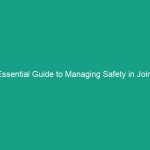Good morning team!
Today, we’re going to talk about a critical topic that affects our Workplace Safety: must-know slip Hazards and Safety Guidelines to prevent workplace accidents. Slip Hazards can occur anywhere, and understanding them is essential to keeping ourselves and our colleagues safe. Let’s dive into why this topic is important and how we can effectively address slip hazards in our daily operations.
Understanding Must-Know Slip Hazards
Slip hazards refer to conditions or situations that increase the likelihood of slipping and falling. These hazards can arise from various sources, including wet floors, uneven surfaces, and cluttered walkways. The importance of understanding these hazards cannot be overstated; slips and falls are among the leading causes of workplace injuries, resulting in lost workdays and significant discomfort for affected employees.
Many employees may think that slips and falls are minor incidents or something that won’t happen to them. However, it’s crucial to recognize that these accidents can lead to serious injuries such as sprains, fractures, and even long-term disabilities. By educating ourselves about slip hazards, we can create a safer work Environment for everyone.
Key Hazards, Risks, and Safety Considerations
Let’s look at some specific slip hazards that we might encounter in our workplace:
- Wet Floors: Spills from drinks, cleaning supplies, or rainwater can create slippery surfaces.
- Uneven Surfaces: Cracks in pavement, loose tiles, or uneven flooring can cause tripping hazards.
- Cluttered Walkways: Items left in hallways or work areas can obstruct pathways and lead to falls.
- Improper Footwear: Wearing inappropriate shoes can reduce traction and increase slip risks.
The real-world consequences of ignoring these hazards can be severe. For instance, a simple spill left unattended can lead to a slip and fall, resulting in an employee being unable to work for weeks. It’s important for us to be proactive in identifying and addressing these hazards before accidents occur.
Best Practices, Procedures, & Actionable Advice
Now that we understand the hazards, let’s discuss some Best Practices and Procedures to minimize the risks associated with slip hazards:
1. Maintain Cleanliness
Ensure that all work areas are kept clean and free of debris. Regular cleaning schedules should be implemented to address spills and messes promptly. If you see a spill, take action immediately—report it or clean it up if safe to do so.
2. Use Warning Signs
Whenever a floor is wet or a surface is hazardous, use brightly colored warning signs to alert others. These signs serve as a visual cue that extra caution is needed.
3. Wear Appropriate Footwear
Always wear shoes that provide good traction and support. If your job requires special footwear, make sure it meets the Safety Standards set by our company.
4. Conduct Regular Safety Inspections
Perform regular inspections of the workplace to identify potential slip hazards. This could include checking for loose tiles, uneven surfaces, or areas where spills commonly occur.
5. Engage in Training and Awareness Programs
Participate in safety training sessions to continuously educate yourself and your colleagues about slip hazards and proper safety practices. Knowledge is key in preventing accidents.
Real-Life Example
Consider the case of an employee who slipped on a wet floor in the break room because no warning sign was posted. This incident resulted in a fractured wrist, requiring medical treatment and time off work. By following safety procedures and maintaining awareness, we can prevent accidents like this from happening.
Regulations, Standards, and Compliance
It’s essential to be aware of the Regulations set forth by OSHA (Occupational Safety and Health Administration) regarding slip hazards. osha mandates that employers must provide a workplace free from recognized hazards, including slip and fall risks. Compliance with these regulations is not only a legal obligation but also a critical component of protecting employees. By adhering to safety standards, we create a safer work environment for everyone.
Employee Engagement & Discussion
Now, let’s open the floor for discussion. What slip hazards have you encountered in your work areas? How did you address them? Sharing our experiences can help us learn from each other and improve our safety practices.
Conclusion & Key Takeaways
In summary, understanding must-know slip hazards and implementing safety guidelines is crucial in preventing workplace accidents. By maintaining cleanliness, using warning signs, wearing appropriate footwear, conducting regular inspections, and participating in training, we can significantly reduce the risk of slips and falls. Remember, safety is a shared responsibility, and it starts with each of us making a commitment to prioritize it.
Thank you, team, for your attention and dedication to creating a safer workplace. Let’s keep safety at the forefront of our minds every day!


